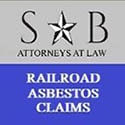
Retired Railroad Workers Were Exposed to Asbestos while working. This exposure has led to the development of a wide range of life-changing illnesses. At Sammons & Berry, P.C. our primary goal is to help those who were unfairly exposed to this toxic material get the compensation they deserve.
Railroad Knowledge Regarding Asbestos Hazards
As early as 1937, the Medical and Surgical Section of the Association of American Railroads recognized that “Silica, asbestos, and lead are the principal substances generating toxic dusts to which railway employees may be exposed.” (See AAR – 1937) By 1958, the Association of American Railroads appears to have been aware that exposure to asbestos caused lung cancer. (See AAR – 1958). In the 1960s and 1970s, strong efforts were being undertaken by the medical and safety communities to identify and prevent various forms of occupational disease. In 1964 Dr. Irving J. Selikoff published his article “Asbestos Exposure and Neoplasia” in the Journal of the American Medical Association in which he observed, “Asbestos exposure in industry will not be limited to the particular craft that utilizes the material. The floating fibers do not respect job classifications.”
Despite this knowledge, railroads continued purchasing and using asbestos-containing products for decades. In a letter, dated July 16, 1971, William J. Harris, Jr., wrote to the Johns-Manville Products Corporation regarding “our mutual concern that asbestos has been placed on the EPA list of hazardous air pollutants.” (See AAR Ltr to JM Re Mutual Concern on Asbestos Standard (7-16-1971). Similarly correspondence from General Motors Electro-Motive Division and General Electric, indicate that asbestos-containing materials continued to be installed on locomotives well into the 1980s. (See EMD – Ltr from EMD Re Asbestos on Locomotives (9-1-1992) GE – Ltr from GE Re Asbestos on Locomotives (8-20-1992). A letter from Union Pacific Railroad Company to the Illinois Central Gulf Railroad, dated February 4, 1981, documents that the Union Pacific was continuing to use asbestos rope in the rail heating and jointing operation. (UP Ltr to IC Re Asbestos Rope (2-4-81). In 1983, Dr. Ernest T. Rouse, Chief Medical Officer for the Missouri Pacific Railroad Company, gave a presentation to the Association of American Railroads in which he acknowledged “The primary exposure of railroad workers at the present time consists of repairing previously used asbestos insulation so that the fibers are in the work environment where these materials have been utilized.” (See Dr Rouse Presentation to AAR (5-14-1982).
Use Of Asbestos In The Railroad Industry
The Steam Era: Railroads have had a long history of using asbestos and asbestos-containing products. During the age of steam locomotives, the boilers on the locomotives were covered with as much 6,000 pounds of asbestos insulation material. The photograph to the left shows two workers literally shoveling asbestos lagging onto a steam locomotive.
Diesel Era: Although diesel locomotives ultimately replaced the steam locomotives, many asbestos-containing products continued to be used on diesel locomotives as well. In fact, well into the 1990s, thousands of locomotives were still in service with asbestos-containing material still on them. Numerous locations on locomotives and rail cars contained asbestos, including:
- Composition brakes shoes;
- Flexible trainline insulation
- Tape used to wrap air compressor pipes on locomotives;
- Insulation on wire covering in locomotives;
- Sprayed insulation on rail cars;
- Pipe joint insulation;
- Barriers in dynamic grid braking systems;
- Packing material in journal boxes;
- Insulation on steam boilers used on passenger locomotives;
- Gaskets and covers on steam generators;
- Heat shields in and around heaters in cabooses;
Manufacturers of diesel locomotives, including General Motors Electro-Motive Division (EMD) and General Electric have acknowledged that asbestos-containing materials continued to be installed on their diesel locomotives until the 1980s. (See Letter from EMD Re Asbestos on Locomotives (9-1-1992) and Ltr from GE Re Asbestos on Locomotives (8-20-1992)). Likewise, many of the major railroads did not begin removing these asbestos-containing materials from their locomotives until the mid-1990s.
Asbestos in Buildings: In addition to asbestos actually installed on locomotives and rail cars, asbestos was commonly used as insulation material inside buildings. In addition to insulation, asbestos was also used in cement products, plaster, floor tiles, acoustical tiles, and sprayed insulation.
Other Sources of Asbestos. In addition to asbestos on rolling stock and in buildings, railroad workers were often exposed to various other sources of asbestos as well. These sources include contamination of rail cars and rail yards from the transport of asbestos containing products, including asbestos containing vermiculite; other products used by the railroad such as asbestos rope used to straighten rails or asbestos products used in rail welding procedures; and exposure to asbestos inside refineries and other industrial locations serviced by the railroad crews.
Retired Railroad Workers Were Exposed to Asbestos and deserve to be compensated for the time they spent with this harmful material. If you or your spouse were employed by a railroad company prior to 1982 we want to hear from you.
Free Asbestos Exposure Consultation in United States
At Sammons & Berry, P.C. we offer a no-cost, no-obligation consultation, so you can discuss the facts of your case without paying for anything upfront. Asbestos trusts claims do not require a lawsuit, depositions, or courtrooms. The process is simple and easy for the client and should not require any stressful legal confrontations for the client. The law firm handles all of the claims for the client, helping you maximize your compensation.
We do not accept any payments from our clients until they receive compensation. We charge on a contingent fee basis, which means you pay a percentage of what you get paid in your claim. If we are unable to collect anything for you, there is no cost to you.
Call (800) 519-1440 to speak with a Sammons and Berry, P.C. representative and start your journey towards compensation.
Wrongful Death Claims For Families of Asbestos Victims
If you have lost someone in your family due to the harmful exposure of asbestos, you may be entitled to compensation. If you can provide the work history and a death certificate for your loved one, our attorneys can help you file an asbestos claim. We understand how difficult this process can be, this is why we work with you every step of the way to help you get the money you deserve. Reach out to our team today to learn more about filing a claim for a family member.
See if you qualify for compensation
Sammons & Berry, P.C.
800-519-1440
View our Google Listing
View our Facebook


